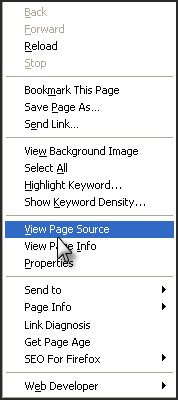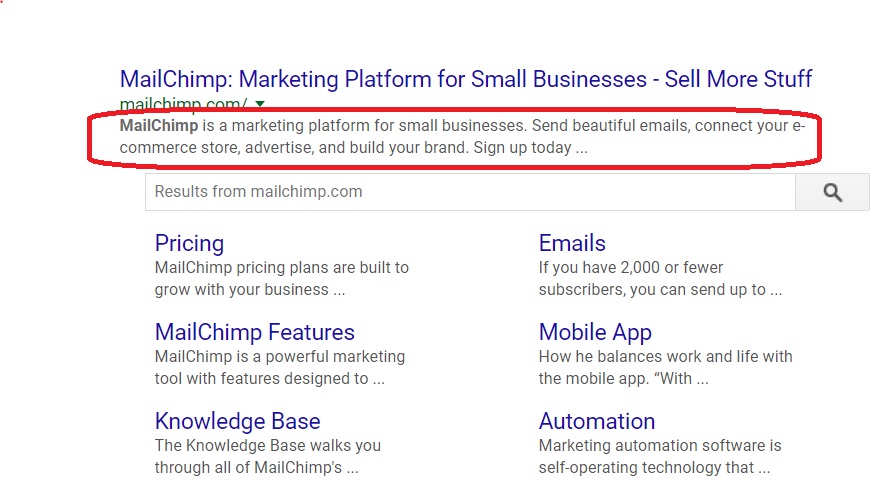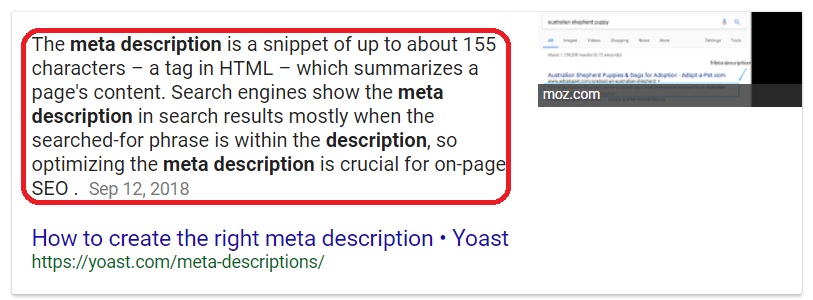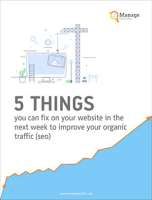There are many different components involved in effective SEO.
If you want to rank higher than your competitors, you need to create stronger content, choose the right keywords to rank for and make sure that you always write for the user first. There’s also one small, but crucial additional element that many companies overlook: the meta description.
A well-written meta description gives your site advantage in the search engine pages, delivers more click-through onto your site, and even increases your chances of conversions. The question is, what is a meta description, and how do you write an effective one?
In this guide to the meta description, WordPress users will learn:
- What a meta description is, and how it affects your SEO
- How other companies use meta descriptions to boost their search engine strategy (with meta description examples)
- How to write the perfect meta descriptions to delight and engage your audience.
Table of Contents
- What is a Meta Description?
- What Are The Characteristics of a Good Meta Description?
- Examples of Great Meta Descriptions & What They Do Right
- 1. MailChimp
- 2. Slack
- 3. YouTube
- 4. Starbucks
- 5. QuickBooks
- How Can I Write Better Meta Descriptions?
- 1. Consider Your Character Count
- 2. Match Your Meta Description to the Title and On-Page Content
- 3. Demonstrate your Value Proposition
- 4. Use Your Keywords
- 5. Test, Monitor and Adjust
- Finishing Thoughts
What is a Meta Description?
A meta description is the small HTML snippet of text that appears underneath your title tag when a customer finds you in the search results. The purpose of this information is to provide the searcher with information about the contents of the page. Google automatically highlights any keywords the user searched for in the meta description with bold font. Here’s a look at the basic anatomy of a search result, and where the meta description fits into the mix:
An optimized meta description on WordPress ensures that your article is more likely to appear in the search results for the right keywords and phrases. It also makes sure that your customer knows exactly what your page is about so that they’re less likely to click on a link and hit the back button straight away (pogo-sticking), leading to a higher bounce rate.
High bounce rates can damage your SEO ranking, so it’s important to take them seriously. To find the meta description on any webpage, all you need to do is right click on the page and click on “view page source.”

What Are The Characteristics of a Good Meta Description?
Importantly, meta descriptions aren’t something the search engines directly consider when ranking your page. A good meta description won’t automatically place you at the top of the search results, but that doesn’t mean that it isn’t valuable.
If you don’t create your own meta description, the Google will typically insert a chunk of text from your content into the space instead. So, you may be wondering why you should bother writing these snippets in the first place.
The simple answer is that your meta descriptions often determine whether your customers choose to click on your website, or visit the site that’s directly above, or below it. While meta descriptions alone might not be a ranking factor, Google has confirmed that “click-through rate” is something that affects SEO.
To get a good click-through rate, your meta descriptions need to have a selection of essential components, including:
- The right length: Google increased the average length of a meta-description to up to 320 characters in December 2017. Ideally, keep your description beneath this length if you want your customers to be able to read all of it.
- The right context: Your meta description needs to describe what the page is about. Let your customers know what value they can expect from your page, without giving all the good stuff away.
- Keywords: Your meta description needs to contain at least one or two primary keywords or phrases. Just make sure that the snippet doesn’t sound unnatural as a result.
- Actionable language: Design your meta description so that it entices your reader to act and click through onto your page. I.e., Want to learn more about meta descriptions? Click here!
Examples of Great Meta Descriptions & What They Do Right
On a basic level, meta descriptions on WordPress articles have one critical function: they tell the search engine and your users what your content is about.
Every page on your website, including your product pages, home page, about page, and landing pages have the ability to share metadata. Optimize your meta descriptions correctly, and you’ll help Google to rank your pages to suit the right target audience. Fail to make the most out of your meta descriptions, and you could be missing out on a valuable addition to your SEO strategy.
The best examples of meta descriptions are often those that follow the basic rules of copywriter. Those are:
- Address your customer’s major problem (what issues do your readers have that you’re going to fix in your article?)
- Introduce a solution (Explain what your page covers, and how it’s going to help the customer in question).
- Describe the outcome (Show your customers what they’ll get from clicking through to your website).
To help you understand the basics of a great meta description, here are a few examples.
1. MailChimp
The meta description for MailChimp’s homepage is informative, simple, and easy to read. It also contains a piece of actionable content “Sign Up Today” that drives customers to take action: The description tells you exactly what you can get from the service, and addresses results available for users: “Real-time data reports,” “Flexible plans,” etc.

2. Slack
You’ll notice that Slack hasn’t used the full 320 characters available in their meta description. Instead, they’ve kept their snippet short and simple, conveying the simplicity of the application itself. Slack tells you exactly what you can accomplish by signing up for the app.

3. YouTube
Great meta descriptions speak directly to the audience and let them know what kind of benefits they can get from clicking on the title tag above. For instance, YouTube’s meta description tells customers that they can share content with family and friends, and “Enjoy the videos and music” they love.

4. Starbucks
The world’s favorite coffee house offers a great example of how to use actionable content in your meta description. Their very first line of content includes the words “shop for coffee.” They’re telling you exactly what you can do on their website while using actionable language to guide user behavior. “Visit a coffeehouse near you” is another great call to action too.

5. QuickBooks
Finally, accounting software company QuickBooks offers plenty of useful information in their meta description designed to drive consumer behavior. You’re told you can use QuickBooks to track sales, profit, and expenses in an “Easy to Use” solution. The description also addresses customer concerns by letting users know that the service is “HMRC recognized” and pushes them to take action by reminding them that they can have a 30-day free trial.

How Can I Write Better Meta Descriptions?
Now that you know what a great meta description looks like, and why they matter to your company, you’re probably wondering how you can improve your snippets.
First of all, it’s worth noting that there’s a plugin available for WordPress that you can use to see your meta description and improve its SEO potential.
Once you know how to access and optimize your meta description, follow these steps:
1. Consider Your Character Count
There’s some debate in the SEO world over how vital counting characters in the meta description is. For instance, SEO company SEMrush exceeded the character count recommended by Google in their description, and their click-through rates were actually higher than they were with a description that came in under the limit.

Ultimately, it’s up to you whether you want your description to stop mid-sentence or not. The best thing you can do is test multiple iterations of your meta descriptions and see which one gets the best click-through rate. However, for the meantime, try not to get too caught up with numbers. Demonstrating your creativity and showing value to your customers is more important than a character count.
2. Match Your Meta Description to the Title and On-Page Content
Your meta description and title tag appear together on the search engine results page, so it’s important they match. Your title tag needs to include the same keyword as your meta description, preferable placed towards the front of the headline, so it’s easier for customers and search engines to pick up.
Use the combined meta description and title tag to inform your readers of exactly what they’re going to get from your content. Additionally, remember that when they click through to your web page, you’ll need to deliver on the exceptional experience you promised. While the world of search is constantly changing, websites with high-quality content always rank higher than those that offer a sub-par experience.
3. Demonstrate your Value Proposition
When you’re writing your meta descriptions, remember the most important rule of copywriting: show your value to your customer. In other words, as you write, make sure that you’re answering the most significant question your consumers have: “What’s in it for me?”

Think about what kind of problems you’re solving with each specific web page. For instance, if you’re writing a meta description for your product page, the snippet should include an insight into what your product’s USP is. If you’re writing a snippet for a blog, it needs to describe the value your audience can take away from the article.
Make sure that your value proposition is different from the other competitors trying to rank for your keywords by taking a look online and listing everything competing companies have to offer their audience. You want to convince your customers that you have something unique.
4. Use Your Keywords
Keywords are one of the most essential elements of SEO, and they’re just as crucial for your meta description as they are for your title tag and your on-page copy. With your meta-description, make sure that you use your keywords naturally throughout the 320 characters. Here’s an example of what good keyword placement might look like:

The keywords appear naturally in the meta snippet, and the content itself is effective at telling readers what they can expect to get when they click on the page in question. Remember, when you’re optimizing your keywords for your meta description, make sure that they appear properly in your title tag too. The best place to position keywords in a title tag is at the beginning of the headline, so that they grab customer attention, and keep the search engines happy at the same time.
5. Test, Monitor and Adjust
Finally, as with anything you do to improve your marketing and SEO efforts online, it’s important to test and monitor your meta descriptions to find out which ones perform best. The more you track your meta descriptions, the more you’ll begin to see which kind of lengths lead to the highest click-through rate. You might also learn that certain call-to-action snippets drive more engagement than others.
As you continue to develop your online presence, don’t be afraid to experiment with your meta descriptions using the best practices of the industry. Just make sure that you avoid duplicate descriptions at all costs. A duplicate snippet can convince Google that you have two of the same page on your website, which means that you lose all of your ranking potential instantly.
Finishing Thoughts
The meta description is one of the most important, but least-discussed components of search engine optimization in the content world. It’s unlikely that meta descriptions are going to disappear anytime soon. So, the quicker you can learn how to develop a good description, the sooner you’ll be able to improve your SEO strategy.
Stop worrying so much about character count and focus on showing your customer the value that clicking on your website can bring. Be engaging, interesting, and unique, and you’ll see results in no time.



